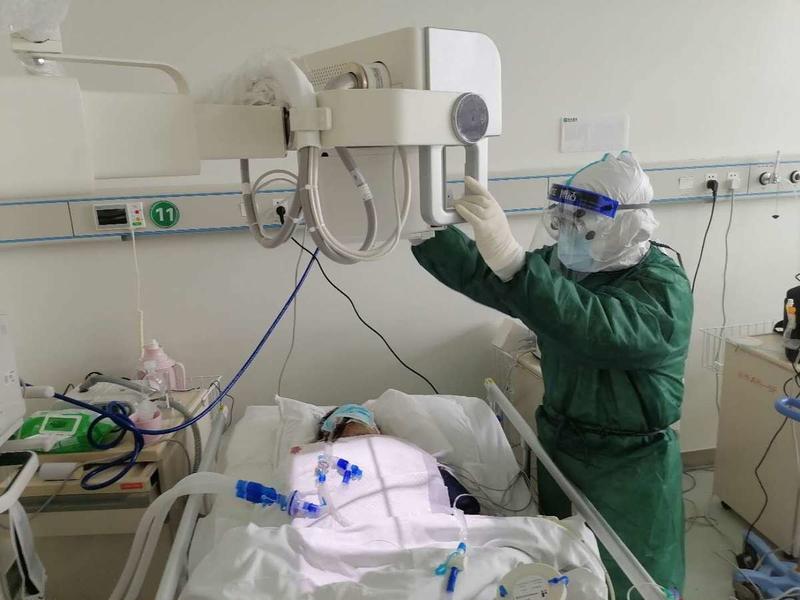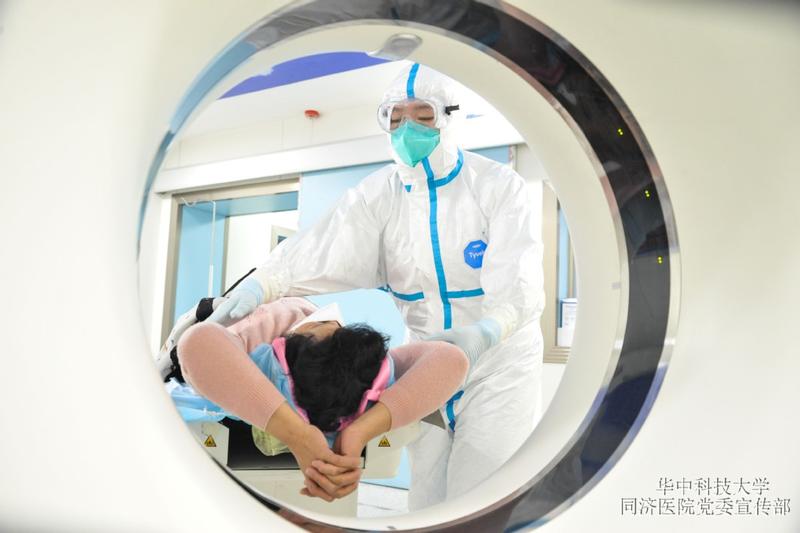 A radiologist uses a portable X-ray machine to examine a novel coronavirus patient at an isolation ward of Tongji Hospital in Wuhan, Hubei province. (PHOTO PROVIDED TO CHINA DAILY)
A radiologist uses a portable X-ray machine to examine a novel coronavirus patient at an isolation ward of Tongji Hospital in Wuhan, Hubei province. (PHOTO PROVIDED TO CHINA DAILY)
Doctor Luo Yi said workers in the radiology department of Tongji Hospital in Wuhan, Hubei province, literally carried a heavier load than others in the battle against the novel coronavirus outbreak.
In addition to the ordinary white or blue protective suit that you see in news reports, we have to wear extra heavy gear that weighs about 8 kilograms to block harmful rays
Luo Yi, a doctor of the radiology department of Tongji Hospital
"In addition to the ordinary white or blue protective suit that you see in news reports, we have to wear extra heavy gear that weighs about 8 kilograms to block harmful rays," he said.
Luo and his colleagues have been on the front line for nearly two months in the hardest-hit city by the virus, with most of their patients in severe or critical condition.
Before the outbreak, the radiology workers had operated in computed tomography scanning rooms, Luo said. However, after the epidemic increased in severity they had to move portable CT machines to the wards to test patients who could not move freely.
A portable CT scanner weighs 300 to 500 kilograms.
The machine is bulky, and Luo's job scanning the lungs of coronavirus-infected patients is a delicate procedure.
 In the battle against the novel coronavirus, CT scans play a crucial role in determining if a patient is infected. (PHOTO PROVIDED TO CHINA DAILY)
In the battle against the novel coronavirus, CT scans play a crucial role in determining if a patient is infected. (PHOTO PROVIDED TO CHINA DAILY)
"Many of the patients are attached to numerous tubes, needles and monitoring wires. Some of those connections are vital and have to be avoided," Luo said. "Placing the patients in a good scanning position improves the accuracy of the result, but each move should be made extremely carefully."
The patience required to conduct the portable testing extended the usual scanning time for a patient from about 10 minutes to nearly half an hour.
Heavier patients also presented a greater problem.
Luo said he scanned one male patient who weighted about 100 kg. The procedure was successfully completed with the help of four doctors. "After the working day, all of us had the clothes under our protective suits soaked in sweat," he said.
Dutiful
Tongji Hospital has received the greatest number of severe cases in Wuhan. More than 2,000 patients in severe condition have been treated at the hospital.
ALSO READ: Probe finds reprimand of doctor inappropriate
In the battle against the novel coronavirus, CT scans play a crucial role in determining if a patient is infected. During the peak of the outbreak, the hospital's radiology department scanned about 1,000 patients a day, nearly 20 times the amount it normally deals with.
Hu Junwu, head of the CT technicians' department said, "Usually, we get about 200 images for each patient, which means more than 200,000 images need to be viewed by doctors on a busy day."
About 100 technicians are divided into four groups that rotate shifts to ensure the department can provide services 24 hours a day and patients can get their reports within two hours. "Most of the technicians stayed at the hospital during the day and seldom went back home. One hasn't been back home for more than 50 days," Hu said.
Tongji Hospital has conducted more than 30,000 CT scans on patients suspected of having the virus. Of those, 600 were done in inpatient wards or the intensive care unit using portable devices.
READ MORE: An ICU doctor in the eye of the storm
"The average age of technicians in our department is only 30. But in facing the challenge of the disease, all the members of our the team have had a strong fighting spirit. Some have canceled their vacations, while others even delayed their wedding," Hu said.
"We all know that no one can remain distant from a contagious disease. As medical workers, we should always keep our duty in mind."


